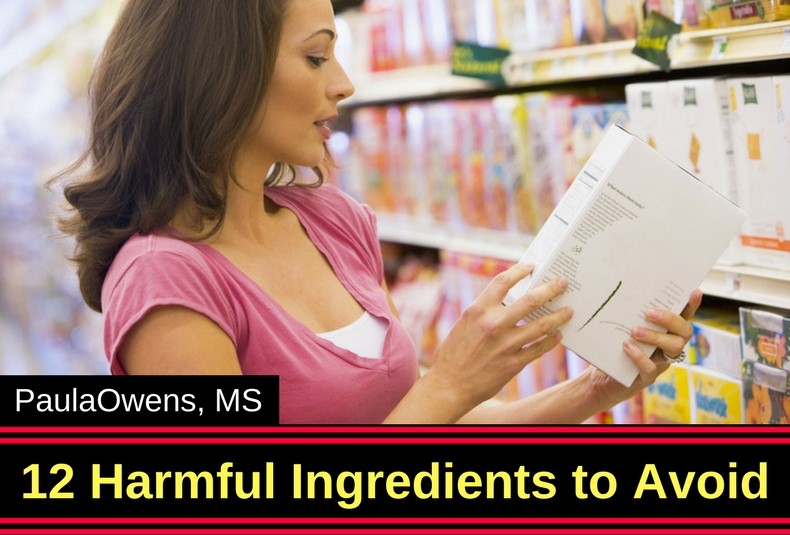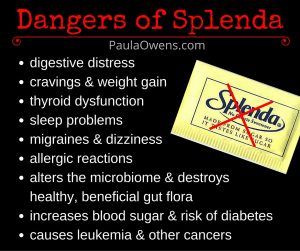
If your goal is to lose weight, look, think, feel and function your best, and live a healthy, vibrant disease-free life, food quality and nutrient-density plus avoiding harmful ingredients and toxic chemicals must be high on your list of priorities.
You’ll find harmful ingredients in many items that you may actually think are healthy, often found in itty-bitty, microscopic print on foods, beverages, personal care and cleaning products. Familiarize yourself with this helpful list of toxic chemicals and harmful ingredients to avoid before you buy them.
Approximately 85-90% of the average American’s diet is from processed and packaged foods, which equates to approximately 10-12 pounds of additives, harmful ingredients and toxic chemicals eaten annually! The majority of packaged and processed foods contain harmful ingredients that are linked to an endless list of adverse health problems, complaints and diseases including obesity, autoimmune disorders, depression, anxiety and even cancer!
Take a “buyer’s beware” approach of the harmful ingredients, damaging additives, GMOs, pesticides, Roundup ready glyphosate, and synthetic chemicals in the food before you buy and eat them or feed them to your family. Become an avid label reader and an ingredient reading detective. Familiarize yourself with the following harmful ingredients.
Become familiar with misleading marketing claims and harmful ingredients. Items labeled as “all-natural, organic, sugar-free, heart-healthy or gluten-free” are not necessarily healthy.
Common items claiming to be healthy
| • Energy bars, protein bars |
• Diet soda, fruit juice, Crystal Light |
| • Cereal, granola, instant oatmeal |
• Multi-grain, whole wheat bread |
| • Vitamin water, sports drinks |
• Agave syrup |
| • Trail mix, dried fruit, fruit roll ups |
• Boxed nut milks |
| • Low-fat and non-fat yogurt |
• Veggie burgers |
| • Soy milk and soy products |
• Most gluten-free foods |
| • K-cup coffee, flavored creamers |
• Nutella |
12 Harmful Ingredients to Avoid at All Costs
1. Fructose and high fructose corn syrup (HFCS) is the number one source of calories for most Americans. Estimates are that Americans consume 70 lbs. of corn sweeteners annually, which is the equivalent of 30 teaspoons of HFCS every day! Aside from weight gain, fructose has been linked to non-alcoholic fatty liver disease (NAFLD), diabetes, inflammation, oxidation and several diseases. Products with fructose also contain high levels of mercury, a neurotoxin. You’ll find fructose in processed, packaged and fast foods, fruit drinks, sodas, syrupy coffee drinks, chewing gum, baked goods, and in hundreds of other processed, packaged food items.
2. Partially hydrogenated oil (trans fats) found in thousands of packaged and processed foods (breakfast cereals, cookies, chips, crackers) are proven to cause heart disease, vascular inflammation and obesity. Restaurant food, especially from fast food chains often serve food loaded with trans fats. Consequences of a diet high in trans fats include decreased IQ, increased inflammation, immune dysfunction, neurological damage, obesity, cancer and diabetes.
Avoid all rancid vegetable oils and other frankenfats such as margarine and fake butter products, oil sprays, cottonseed, canola and soybean oil.
3. Monosodium glutamate (MSG) is a chemical food additive associated with seizures, rashes and hives, infertility, depression, obesity, panic attacks,
migraines, permanent damage to the endocrine system, and other serious disorders.
Especially harmful to developing fetuses, children and the elderly, MSG is an excitotoxin. MSG overexcites brain cells to the point of death! MSG is found in frozen meals, ramen noodles, soups, chips and numerous packaged foods. It’s used as a taste enhancer and has over 50 different names that are used to disguise it on food labels.
4. Processed soy contains phytoestrogens, plant-based estrogens that are similar to and mimic estrogen. Before you mix up a soy protein shake, snack on a soy protein bar or pour yourself a glass of soy milk, consider this: 93% of all soy in the U.S is genetically engineered, soy inhibits the thyroid, soy is estrogenic, an anti-nutrient, it’s deficient in amino acids, contains aluminum, is toxic to infants, and it shrinks the brain!!! No thank you!
There are some redeeming qualities to soy, however these are found primarily in fermented soy products only. If you want to reap some of the health benefits from soy, do so in moderation and stick with organic, fermented forms only.
Pass on processed soy including soy milk, infant formula, tofu, soy burgers, soy protein powder, soy ice cream, soy cheese, and other soy junk foods that are disguised as health foods.
Avoid any item containing this harmful ingredient: soybean oil! Please don’t feed it to your baby or your pets either!
Hidden sources of soy-based ingredients are often found in bread, ice cream, margarine, chips, poor quality vitamins and fish oil, pet food, vegetable oil and processed, packaged and fast foods.
Approximately 98% of soybean production in the U.S. is genetically-modified and used for livestock feed. Remember, you eat what the animal ate! Choose organic!
5. The B chemicals: Potassium bromate, bromated vegetable oil, BHA and BHT, sodium benzoate. Potassium bromate, a chemical food additive and known carcinogen is found in baked goods, breads and tortillas. Bromated vegetable oil (BVO) is a synthetic chemical derived from soy or corn that is found in Mountain Dew, citrus sodas and some Gatorade products. BVO contains bromine, a flame retardant for plastics banned in foods throughout Europe and Japan. BVO accumulates in fatty tissue causing behavioral, reproductive and organ damage, neurological disorders, early puberty and heart problems.
Bromine (fluoride and chloride) are halogens that displaces iodine, which can compromise thyroid function.
Sodium benzoate is a chemical preservative found in carbonated beverages and salad dressings. It’s also used to preserve and treat meat and poultry products.
BHA and BHT, made from petroleum and coal tar. They’re chemical preservatives (carcinogens) that are toxic to the liver, gallbladder and kidney, plus they damage mitochondrial health. You’ll find BHA and BHT in processed and packaged foods including cereals, chewing gum, chips, processed meats, vegetable oils, margarine and baked goods.
6. Sugar is 8x more addictive than cocaine altering brain and body chemisty, behavior and psychological function. Consuming sugar in its many forms (grains, wheat, candy, juice, cereals, soda, bagels and more) promotes inflammation, mitochondrial damage, and oxidation, triggers cravings, increases appetite, risk of depression, heart disease, ADHD, diabesity and other diseases. Sugar is the perfect fuel source for yeast, Candida overgrowth and parasites. Sugar overload causes magnesium, vitamin B and several other
nutrient deficiencies, accelerates aging, wrinkles, and the production of free radicals, which cause collagen to breakdown creating wrinkles.
Of the nearly 600,000 food items on grocery store shelves, 80% of them contain added sugar!
Avoid any harmful ingredient or item that ends with –ose (a sugar), evaporated cane juice, barley malt, brown rice syrup and hidden sources of sugar found in processed, packaged and fast foods and beverages.
7. Sodium chloride (commercial table salt) found in microwave dinners, take-out items, restaurant food, and processed foods is highly processed, contains aluminum, toxic chemicals and additives that cause neurological disorders, multiple sclerosis and other autoimmune disorders. We need salt, however quality matters! Opt for a healthier version: unprocessed Celtic sea salt.
8. Artificial sweeteners (Aspartame, Splenda, Equal, Sweet ‘N Low, Sucralose, Saccharine, TruVia, Acesulfame-K). This includes the little blue, yellow & pink packets too!
Splenda consists of sucralose, which contains chlorine (originally a pesticide), and fillers, maltodextrin and glucose. It’s about 600x sweeter than sugar.
Splenda is toxic to the brain and thymus, causes GI distress, weight gain, thyroid dysfunction, alters gut microflora, and destroys beneficial bacteria in your gut.
Splenda affects expression of certain enzymes known to interfere with nutrient absorption and medications.
Aspartame is an excitotoxin and neurotoxin that comes with a laundry list of side effects. Aspartame and artificial sweeteners stimulate appetite, intensifies carbohydrate and sugar cravings, cause bloating, digestive and liver dysfunction, migraines, weight gain, microbiome problems, increased risk of depression, bone loss, stroke, heart disease, type 2 diabetes, ADHD, brain seizures and tumors, rashes, hives, and cancer.
You’ll find artificial sweeteners hiding in thousands of items including desserts, gelatin, low calorie foods, fruit drinks, breath mints, sugar-free gum, sports drinks, wine coolers, flavored bottled waters, cereals, cold remedies, medications, infant formula, some vitamins and protein powders and of course, diet sodas.
9. Wheat, corn, grains and gluten create a reaction in the intestines that sets off a laundry list of adverse symptoms. The ultimate effect of this hidden wear and tear is the slow destruction of the lining of the small intestine causing gut permeability,
leaky gut syndrome, chronic low-level inflammation,
nutrient deficiencies, digestive disorders, constipation or diarrhea, and
autoimmune responses.
All grains are sprayed with
Round Up (glyphosate). Grains have elevated levels of mycotoxins, which are endocrine disruptors. Rice contains high levels of arsenic.
Processed, refined grains are void of nutrients, disrupt hormones and insulin levels, they’re addictive for many individuals, sprayed with pesticides, and come with a laundry list of adverse health conditions for most people.
10. Genetically modified (GM) foods are those derived from a process in a lab where genes are taken from one species and inserted into another in an attempt to obtain a desired characteristic or trait. Often referred to as frankenfoods, GMOs alter and disrupt DNA. Children, newborns and pregnant women face the greatest potential danger from GM food.
A study published in the Journal of Biological Science revealed numerous health hazards from GMOs and pesticides, specifically liver and kidney function, and damage to the heart, adrenal, spleen and blood cells. Side effects from GMOs include infertility, immune dysfunction, accelerated aging, faulty insulin regulation, autism, arthritis, increased food allergies, autoimmune disorders, cancer, and the GI distress.
The United States does not require labeling of GM foods. The most common genetically engineered crops in the U.S. include corn, soy, alfalfa, Hawaiian papaya, summer squash, sugar beets, cottonseed and canola. If you eat processed foods, you’re consuming GMOs. All processed food items contain at least one or more genetically modified ingredient.
11. Caramel coloring, artificial colors and dyes (Blue 1, 2; Red 3, 40; Green 3; Yellow 5, 6) have been linked to ADHD, OCD and behavioral problems in children, lower IQ, altered brain chemistry, depression, hormonal dysfunction, allergies, migraine headaches and cancer.
Carmel coloring and artificial colors and dyes are harmful chemicals found in soda, energy and sports drinks, candy, cereals, pastries and baked goods, pet food, sausage, canned items, cough syrup, some vitamins and pharmaceutical drugs.
Take home message: Avoid any item that includes a color plus a number listed on the ingredients.
12. Carrageenan is a food additive extracted from red seaweed that is widely used in food and beverages as a thickener and stabilizer. It’s been linked to insulin resistance, glucose intolerance, severe GI inflammation, increased risk of intestinal lesions, ulcerations, colon cancer and even malignant tumors. You’ll find carrageenan hiding in items claiming to be “natural” and “organic” such as coconut and almond milk, luncheon meat, yogurt and many other items.
Take-away Tips to Avoid Harmful Ingredients
-
-
Choose organic versus conventional as much as possible. Do your best avoid the
Dirty Dozen fruits and veggies.
-
Focus on nutrient-dense, real foods like those our grandparents and ancestors ate. This is one of the best ways to avoid toxic chemicals and harmful ingredients.
-
Beware of chemicals in the cosmetics you put on your skin and personal care products, which compromise the lymph and liver, and increase exogenous estrogen load.
-
Look for and avoid parabens, phthalates and artificial fragrances in your skincare and personal care products. Notable harmful ingredients to avoid include sodium lauryl/laureth sulfate, aluminum, proplylene glycol (PEG), butylated hydroxy anisole (BHA), butylated hydroxy toluene (BHT), diethanolamine (DEA), and quite a few others.
-
The average woman puts 300-500 chemicals on her body every day. Anything you put on your skin is absorbed into the blood stream.
DIY Skin and Beauty Recipes
-
Be an avid label reader is one of the best ways to avoid harmful ingredients.
-
Choose to shop at your local Farmers Markets, local farms or other natural health food store.
Related Posts
 If your goal is to lose weight, look, think, feel and function your best, and live a healthy, vibrant disease-free life, food quality and nutrient-density plus avoiding harmful ingredients and toxic chemicals must be high on your list of priorities.
If your goal is to lose weight, look, think, feel and function your best, and live a healthy, vibrant disease-free life, food quality and nutrient-density plus avoiding harmful ingredients and toxic chemicals must be high on your list of priorities.

